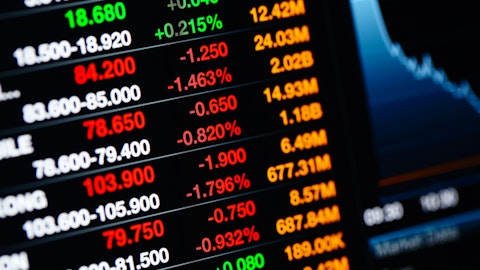Concerns over a shift in Fed’s easy monetary policy have hit several hedge funds hard during the third quarter. A number of sectors are in correction territory. More importantly, Russell 2000 ETF (IWM) underperformed the larger S&P 500 ETF (SPY) by more than 14 percentage points between June 25, 2015 and October 30, 2015. Hedge funds and institutional investors tracked by Insider Monkey usually invest a disproportionate amount of their portfolios in smaller cap stocks. We have been receiving indications that hedge funds were paring back their overall exposure and this is one of the factors behind the recent movements in major indices. In this article, we will take a closer look at hedge fund sentiment towards QUALCOMM, Inc. (NASDAQ:QCOM).
QUALCOMM, Inc. (NASDAQ:QCOM) shares haven’t seen a lot of action during the fourth quarter. Overall, hedge fund sentiment was unchanged and the stock was in 68 hedge funds’ portfolios at the end of the fourth quarter of 2015. At the end of this article we will also compare QCOM to other stocks including U.S. Bancorp (NYSE:USB), Toronto-Dominion Bank (USA) (NYSE:TD), and UBS AG (USA) (NYSE:UBS) to get a better sense of its popularity.
Follow Qualcomm Inc (NASDAQ:QCOM)
Follow Qualcomm Inc (NASDAQ:QCOM)
Receive real-time insider trading and news alerts
Today there are many gauges shareholders can use to appraise publicly traded companies. A pair of the less utilized gauges are hedge fund and insider trading indicators. Our researchers have shown that, historically, those who follow the best picks of the best fund managers can trounce the market by a significant margin (see the details here).
Among Qualcomm’s largest shareholders is activist fund JANA Partners, managed by billionaire Barry Rosenstein. In its third-quarter investor letter, JANA discussed its investment in Qualcomm. Another fund that discussed its bet on the company is Wedgewood Partners. Here’s what both investors said about the company:
“QCOM traded in a wide range during the third quarter as investors fear the impact of the China slowdown on smartphone sales while awaiting the outcome of the board’s strategic review process, which we expect to be announced before year end. Press reports emerged during the quarter that Samsung will return to using Qualcomm’s Snapdragon 820 chips for some of its upcoming Galaxy S7 phones, to be shipped next year. This is unequivocally positive news for QCOM’s QCT segment, a short cycle semi-conductor business that has seen revenues and margins collapse during our investment period with the loss of Samsung’s Galaxy S6. Next year sets up for a much different margin trajectory based on the significant cost realignment underway: any incremental business from Samsung is an additional benefit. Qualcomm’s QTL segment currently accounts for 80%+ of overall FY16 earnings, yet QCOM is currently quoted at a P/E of less than 10x (ex-cash), a discount to the trading levels of its more capital intensive semiconductor peers. We continue to believe the value embedded in QCOM far exceeds the price at which it is available in the market, and that the Strategic Realignment Plan being advanced by management and the board has the potential to drive substantial returns going forward,” JANA said.
“Qualcomm continued to detract from relative performance during the second quarter. However, we are still maintaining Qualcomm as the largest weighting in portfolios (excluding cash), as its absolute risk-reward proposition skews very favorably, compared to alternative opportunities. Earlier this year a key overhang was removed after Qualcomm settled an investigation by China’s National Development and Reform Commission (NDRC), regarding alleged anti-monopoly violations. Prior to the settlement, Qualcomm’s licensing business was not effectively participating in the local smartphone market, as many original equipment manufacturers (OEM) flouted the Company’s wellestablished, globally recognized intellectual property. That said, we believe most of the non-compliant OEMs do not compete in Western markets, much less outside of China, which is where Qualcomm generates the vast majority of its licensing revenues. As Qualcomm’s IP is increasingly enforced across China’s emerging smartphone OEMs we estimate the settlement could represent 5% to 10% upside for earnings over the next few years. While Qualcomm’s licensing business represents about two-thirds of the Company’s profitability, the chipset business represents most of the balance. Qualcomm’s chipset business has stumbled of late, losing key application processor sockets to in-house rivals, particularly Samsung, while ceding share to MediaTek in basebands. Though Qualcomm’s chipset business is witnessing increased competition, the Company’s ubiquitous “system on a chip” platform, and pioneering technology in mobile connectivity has them maintaining over half the revenue share in the application processor and baseband markets. Despite these near-term pressures, we see this as more than priced into shares. At just over $100bn in market cap, Qualcomm has about $20bn in net cash on the balance sheet after the Company issued $10bn in debt (about half of that at rates lower than or equal to the current dividend yield) with the intention of executing an accelerated repurchase program. Further, if we capitalize the still-growing income stream from Qualcomm’s licensing business – even assuming a sub-market multiple – we surmise that shares imply close to zero value (and maybe even slightly negative) for the Company’s chipset business. In other words, effectively winding down the chipset business would generate more value than what the market is assigning it, which is quite draconian, considering Qualcomm’s still dominant presence in mobile chipsets, and growing licensing franchise,” according to Wedgewood’s second-quarter letter to investors.
Keeping this in mind, we’re going to take a gander at the new action encompassing QUALCOMM, Inc. (NASDAQ:QCOM).
What have hedge funds been doing with QUALCOMM, Inc. (NASDAQ:QCOM)?
At Q4’s end, a total of 68 of the hedge funds tracked by Insider Monkey were long this stock, a change of 0% from the third quarter. With the smart money’s positions undergoing their usual ebb and flow, there exists a few notable hedge fund managers who were increasing their stakes substantially (or already accumulated large positions).
When looking at the institutional investors followed by Insider Monkey, William B. Gray’s Orbis Investment Management has the most valuable position in QUALCOMM, Inc. (NASDAQ:QCOM), worth close to $960.9 million, corresponding to 7.5% of its total 13F portfolio. The second largest stake is held by Generation Investment Management, led by David Blood and Al Gore, holding a $662.3 million position; 8.5% of its 13F portfolio is allocated to the company. Some other members of the smart money that hold long positions contain John H. Scully’s SPO Advisory Corp, Ken Fisher’s Fisher Asset Management and Barry Rosenstein’s JANA Partners.
On the other hand, Karthik Sarma’s SRS Investment Management dropped the largest investment of all the hedgies watched by Insider Monkey, worth close to $53.7 million in stock, and Gordy Holterman and Derek Dunn’s Overland Advisors was right behind this move, as the fund cut about $52.7 million worth of shares. These transactions are interesting, as aggregate hedge fund interest stayed the same (this is a bearish signal in our experience).
Let’s now review hedge fund activity in other stocks similar to QUALCOMM, Inc. (NASDAQ:QCOM). We will take a look at U.S. Bancorp (NYSE:USB), Toronto-Dominion Bank (USA) (NYSE:TD), UBS AG (USA) (NYSE:UBS), and Mondelez International Inc (NASDAQ:MDLZ). This group of stocks’ market valuations are similar to QCOM’s market valuation.
| Ticker | No of HFs with positions | Total Value of HF Positions (x1000) | Change in HF Position |
|---|---|---|---|
| USB | 41 | 5314294 | -2 |
| TD | 14 | 301226 | -2 |
| UBS | 13 | 856422 | 0 |
| MDLZ | 57 | 6661359 | -12 |
As you can see these stocks had an average of 31 hedge funds with bullish positions and the average amount invested in these stocks was $3.28 billion. That figure was $5.33 billion in QCOM’s case. Mondelez International Inc (NASDAQ:MDLZ) is the most popular stock in this table. On the other hand UBS AG (USA) (NYSE:UBS) is the least popular one with only 13 bullish hedge fund positions. Compared to these stocks QUALCOMM, Inc. (NASDAQ:QCOM) is more popular among hedge funds. Considering that hedge funds are fond of this stock in relation to its market cap peers, it may be a good idea to analyze it in detail and potentially include it in your portfolio.




